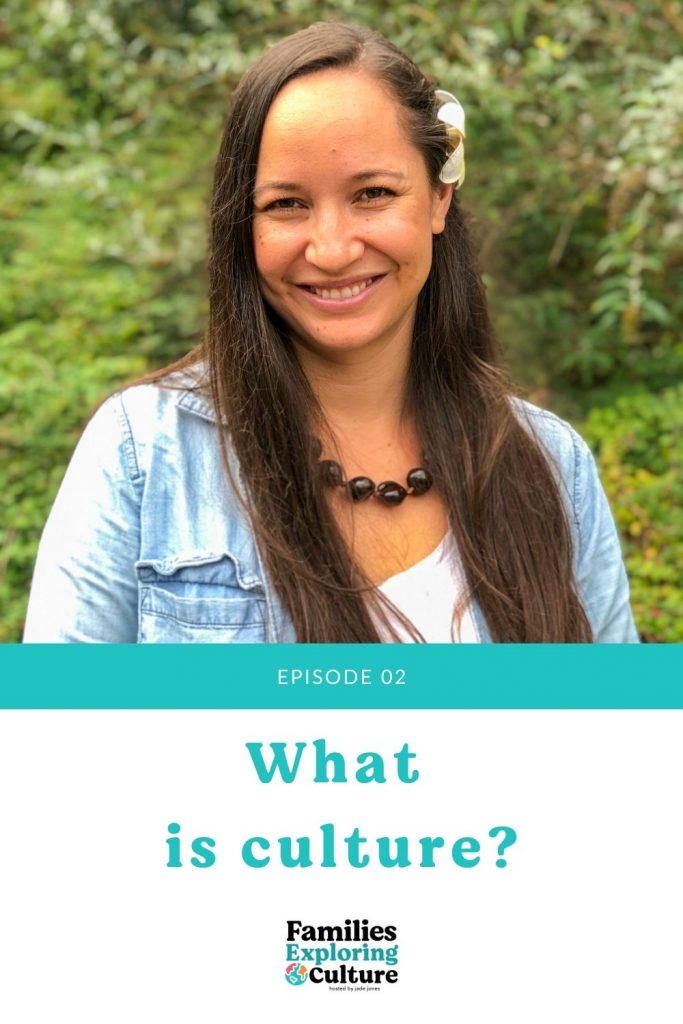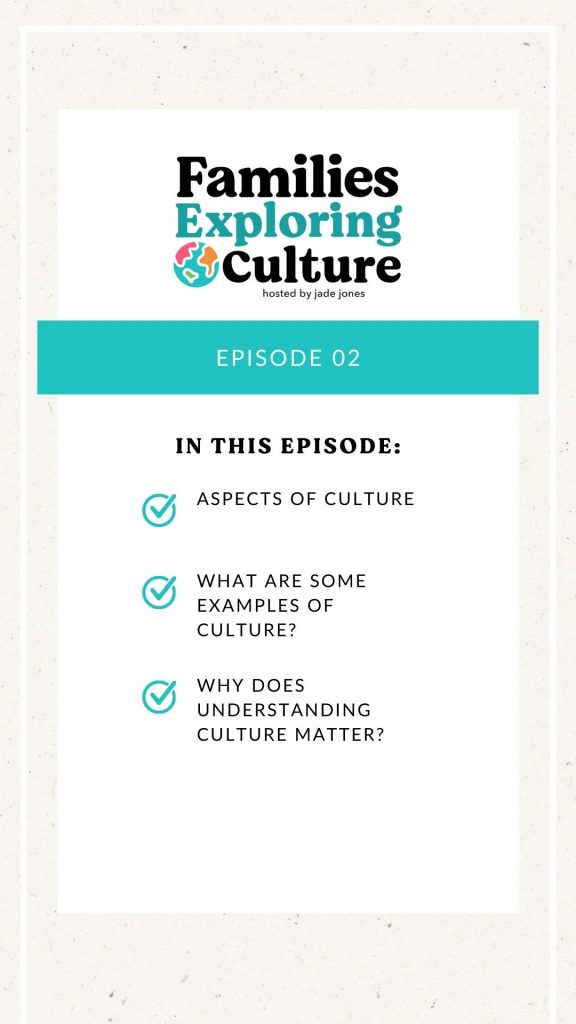02: What is culture?
On the second episode of the Families Exploring Culture podcast, we discuss what culture is, aspects and examples of culture, and why cultural awareness is so important.
In episode 1 of the podcast, Expanding Our Understanding of the World, we discussed what that means and why understanding other cultures matters. Before we can dive deeper into how to explore new cultures we first need to cover exactly what we mean by culture.

What is culture?
Culture is defined as a set of behaviors, dress, food, language, values and traditions that are shared by a specific group of people.
There are an endless variety of cultures that each have their own distinct beliefs, traditions, and values. Often these include certain clothing styles or colors, specific languages, phrases, or possibly acronyms.
Some of these cultures we interact with might include religion, race, ethnicity, community, sports, profession, country, education, and family.
How is culture created?
Culture is not an inherent trait that we are born with. It is something learned. We must learn it through experience or be taught it by those who are familiar with the cultural traditions.
We pass on culture from one generation to the next. This is also why cultural norms can change as the values and beliefs change from one generation the next.
“Because of our traditions, we’ve kept our balance for many, many years. Here in Anatevka we have traditions for everything- how to eat, how to sleep, how to wear clothes. For instance, we always keep our heads covered and always wear a little prayer shawl.This shows our constant devotion to God. You may ask, how did this tradition start? I’ll tell you- I don’t know! But it’s a tradition. Because of our traditions, everyone knows who he is and what God expects him to do…Without our traditions, our lives would be as shaky as- as a fiddler on the roof!”
-Tevye, Fiddler on the Roof

Aspects of culture
In the book Third Culture Kids, the author refers to anthropologist Gary Weaver’s analogy of culture being like an iceberg. There are two parts of the iceberg- that which is easily visible above the water and that large part that is hidden beneath the water.
Visible Culture
The part of the iceberg above the water is the surface culture, or the parts of culture that we can see or hear. This includes the clothes we wear, the language we speak, and the behaviors and customs we have.
Invisible Culture
The part beneath the surface is what Weaver terms as deep culture. This invisible culture includes our beliefs, values, and how we view the world around us.
How we view someone’s culture influences how we interact with them. The visible culture is what we use to help us know what the invisible culture will be.
This can lead us to make assumptions about another person and their understanding of what we believe to be a shared culture when that is actually not the case.
What are some examples of culture?
Communication
How about the way we communicate? In talking with our Chinese friends they have shared how they have struggled a bit in talking with the Dutch.
In Chinese culture you “beat about the bush” but the Dutch are extremely direct. So they have struggled in getting what they want or need because they are not used to stating it outright.
My friends from the UK have shared how they feel the Dutch are not direct but blunt to the point of being considered rude.
Naming
Even something as simple as the way you name your children is cultural.
In Hawaiian culture, we believe that the names you give your children are what they will become. If you name your child whirlwind, they will be a whirlwind just ask my parents!
While living in the Netherlands we’ve learned that in Ghana families will give children a name but they also have a home name one that is based on the day of the week they were born.
In Hong Kong, it is common to call a child by their position in the family instead of their given name.
In Iceland, they do not have a family name like Jones or Smith. Instead they are called their father’s son or daughter.
All very different ideologies behind naming, none of them are wrong, just different.
Why is cultural awareness important?
We all belong to a variety of cultures that shape who we are, how we think, feel, and act, how we make decisions and treat others.
It is so easy to look at the way another culture does something (especially from the outside) and judge it based on our own perceptions that are cultivated by the standards of our culture. What may seem odd or wrong to us is normal to others and the same is true for the reverse.
Cultural norms are a fluid concept, constantly shifting with the change in beliefs and values of each generation. We want to keep a hold on those traditions that are positive while shedding the negative ones.
What should we know about learning about different cultures?
As we are learning about how others live, we can do so with an open mind. We can learn and grow as we learn about others and perhaps discover new ways that can also work for us.
Being open to new ideas, I feel, is an essential part of this learning process. Listen first to learn without placing your own judgements on what is being said or what you may or may not agree with.
We all have biases and to overcome them requires showing others the love and respect we would want in return. These are the moments that draw us together and help us grow to love one another.
Thank you for joining me on this journey! Happy exploring!

Listen to episode 2 of the Families Exploring Culture Podcast here:
Show links:
Culture definition: https://dictionary.cambridge.org/dictionary/english/culture
Third Culture Kids: Growing Up Among Worlds by David C. Pollack and Ruth E. Van Reken
